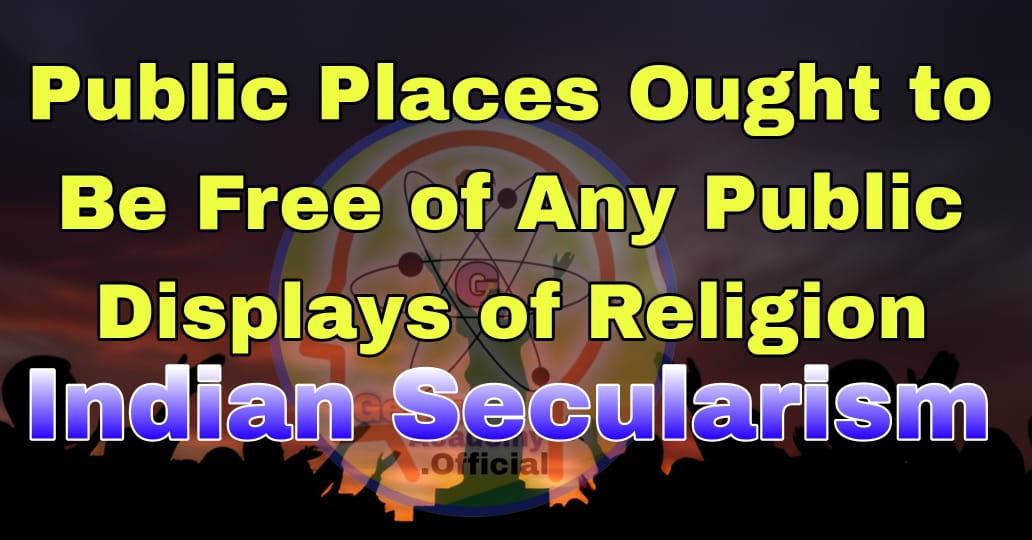Public Places Ought to Be Free of Any Public Displays of Religion
India is a land of immense diversity, not only in culture and language but also in religion. With followers of multiple faiths, including Hinduism, Islam, Christianity, Sikhism, Buddhism, and Jainism, as well as smaller communities practicing various other religions, the country embodies a complex tapestry of beliefs. This pluralistic ethos is safeguarded by the Indian Constitution, which guarantees the right to profess, practice, and propagate one’s religion. However, this right is not absolute. It is subject to reasonable restrictions in the interest of public order, decency, morality, and state interests.
The debate on whether public places ought to be free of any displays of religion stems from the need to balance individual religious freedoms with the collective rights of a secular society. Public spaces are shared by people of diverse faiths, and overt religious displays in these spaces can sometimes lead to social friction, disrupt public order, or marginalize minority groups.
The Constitutional Framework
Article 25(1) of the Indian Constitution provides every individual the “freedom of conscience and the right freely to profess, practice, and propagate religion.” This guarantees the right to express one’s faith without undue interference. However, this freedom is not unlimited. The Constitution explicitly states that these rights are subject to public order, morality, and health.
The judiciary has often emphasized the significance of these limitations. For instance, in the Ananda Margi Case (1984 and 2004), the Supreme Court denied permission for processions involving Tandava dance in public spaces, citing concerns over public order. Similarly, the Gulam Abbas vs. Uttar Pradesh case (1984) highlighted the potential for religious displays to exacerbate communal tensions, as demonstrated by the century-old dispute between Sunni and Shia sects over a graveyard.
These cases underscore the principle that while religious freedoms are inviolable in private spaces, public displays of religion must align with constitutional values of secularism and public order.
Public Spaces: Secular by Design
Public places, by their very nature, are shared spaces meant for the common good. They include parks, streets, government buildings, and educational institutions, among others. The idea of keeping such spaces free from overt religious displays is rooted in the principle of secularism. India’s secularism differs from the Western model in that it does not advocate a strict separation of religion and state but instead ensures that the state treats all religions equally.
When public places become venues for religious expression, it can lead to several challenges:
- Exclusion and Alienation: Public displays of religion in shared spaces can alienate those who do not subscribe to the dominant faith. For example, a park adorned with religious symbols or events might deter people from other communities from feeling welcome.
- Communal Tensions: Public religious displays can sometimes spark conflicts, especially in areas with a history of communal tensions. Such displays can be perceived as assertions of dominance by one group over others.
- Erosion of Secularism: Allowing overt religious expressions in public spaces undermines the secular ethos of the state, which aims to create a neutral and inclusive environment for all citizens.
The Need for Restrictions
The restrictions on religious displays in public places are not meant to suppress religious freedom but to ensure harmony and equality in a pluralistic society. Key reasons for imposing such restrictions include:
1. Public Order
Religious displays can lead to disruptions, especially during festivals or processions that block roads or create noise pollution. The judiciary has repeatedly upheld restrictions on religious activities that disturb public order. For instance, the Hijab Row in Karnataka highlighted the need to prioritize educational uniformity over individual religious expression in public institutions.
2. Equality and Inclusivity
Public spaces belong to all citizens, regardless of their faith. Overrepresentation of one religion in public spaces can marginalize minorities and create an unequal environment. Maintaining neutrality ensures that no group feels excluded.
3. Avoidance of Communal Polarization
India’s history is marred by communal violence, often triggered by religious displays or disputes. By keeping public spaces free from religious symbols or practices, the state can reduce the likelihood of such incidents.
Arguments Against Restricting Religious Displays
Despite the rationale for restrictions, opponents argue that public displays of religion are an extension of individual freedoms and cultural expression. Some key arguments include:
1. Freedom of Expression
Restricting religious displays in public spaces may be viewed as a violation of the right to freedom of expression. For many individuals, religious identity is integral to their sense of self.
2. Cultural Diversity
India’s vibrant culture is deeply intertwined with religion. Festivals like Diwali, Eid, and Christmas often involve public celebrations, which are seen as a reflection of the country’s rich heritage.
3. Precedent of State Support
The state itself often participates in religious events, such as organizing pilgrimages or funding religious festivals. Critics argue that banning public displays of religion is inconsistent with such practices.
Striking a Balance
The challenge lies in reconciling the right to religious freedom with the need for secular public spaces. This can be achieved through a nuanced approach:
1. Regulating, Not Banning
Rather than an outright ban, the state can regulate public displays of religion to ensure they do not disrupt public order or alienate other communities. For example, permissions for religious processions can be granted with conditions regarding time, location, and noise levels.
2. Promoting Shared Spaces
Public spaces can be designed to reflect India’s pluralistic ethos. Instead of being dominated by symbols of one religion, they can feature secular or multi-faith motifs that represent unity in diversity.
3. Educational Campaigns
Awareness campaigns can help foster understanding and tolerance among communities. Educating citizens about the importance of secular public spaces can reduce resistance to restrictions on religious displays.
The Ethical Perspective
From an ethical standpoint, public displays of religion must be evaluated on the principles of fairness and respect for diversity. While individuals have the right to express their faith, this right should not infringe upon the rights of others to feel safe and included in public spaces.
The controversy surrounding the Hijab Row in Karnataka highlights the ethical dilemmas involved. While the students’ right to wear religious attire is valid, the school’s responsibility to maintain uniformity and inclusivity is equally important. Ethical decision-making in such cases requires balancing individual rights with collective welfare.
Global Comparisons
Countries like France adopt a strict secular model, banning overt religious symbols in public institutions. While this approach ensures neutrality, it has faced criticism for infringing on individual freedoms. On the other hand, the United States allows public displays of religion but ensures that such displays do not violate the principle of non-establishment.
India must chart its own course, taking into account its unique socio-religious context. A middle path that respects individual freedoms while preserving the secular character of public spaces is essential.
Conclusion
Public places ought to be free of any public displays of religion to maintain the secular and inclusive ethos of India. While the right to religious freedom is fundamental, it must be exercised in a manner that respects the diversity and equality of all citizens. By regulating religious displays in public spaces, the state can ensure harmony, prevent communal tensions, and uphold the constitutional values of secularism.
However, this does not imply the suppression of religious expression. Instead, it calls for a balanced approach that accommodates the cultural and spiritual needs of individuals while safeguarding the collective interests of society. Through thoughtful policies, public education, and inclusive governance, India can uphold its pluralistic heritage and ensure that public spaces remain neutral, welcoming, and reflective of its rich diversity.
_

